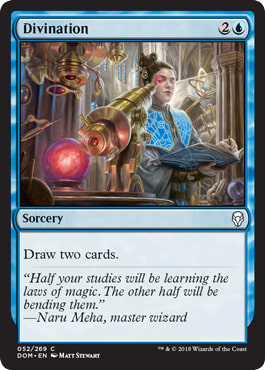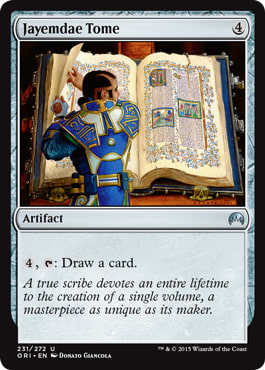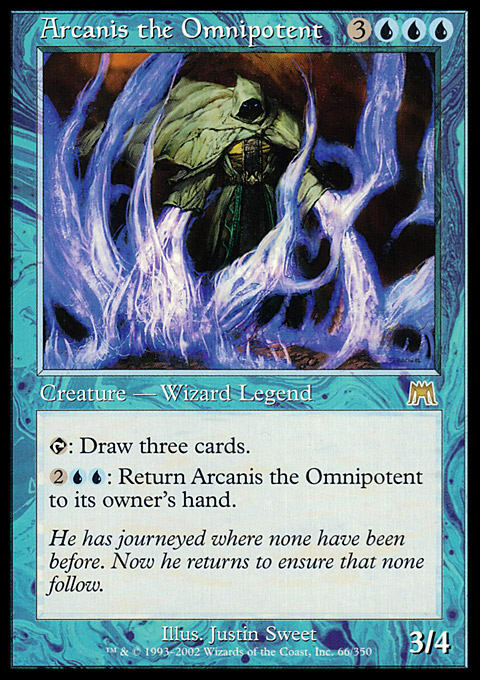Writing about Magic would be easier if there weren’t years of works behind us. We could craft work and discover new ideas with greater ease. Yet, today, there is a skeleton out there that defines how the game is played. There is a treasure trove of information about the game at our easy disposal thanks to the ubiquity of the Internet. There is no reason someone who is writing a Magic article should not go into it without the information needed to provide quality work. First, we had ideas; then, we acquired the skills. Now we need the knowledge.
Lesson #3: Do the Research
When it comes to Magic writing, there are two key types of research. The first is what one tends to think about when one hears that word: poring over literature and resources and trying to draw conclusions. This works best when writing about a theoretical approach from the game. There is a library of articles out there on approaching the game above the table, and before writing any such piece, it follows that a basic understanding of the underlying concepts is required. This style of research also encompasses articles wherein you are linking Magic to a well-established field outside the game.
The other, and larger, bucket of articles fall into the camp of experiential research. These are the deck primers and tournament reports, the Limited breakdowns and format analyses. While doing a review of previous literature might make sense in these instances, far more often, this is going to be going out into the field and drawing conclusions. Experiential articles can also include interviews.
While it is important to understand what the main focus of your piece will be, remember this: These ideas are not mutually exclusive. It is correct to merge these two styles when warranted. Remember that everything must serve your hypothesis, and that also means providing all reasonable forms of support.
Moving backward, let’s look at experiential research first. This appears easier to gather, as it is all coming from the first person. However, this can be tricky. For example, what happens if you go to a tournament and only decide to write your narrative after the fact? Is this going to be a comprehensive story of your triumph or is it going to be a loose connection of anecdotes?
Sometimes, this is going to unavoidable. There are ways to avoid this through good habits. While it is common practice to keep track of your life total with pen and paper, making notes of tricks that could impact future games can help here. If writing is something you intend to do at any point, taking detailed notes might be your solution. I am not advocating writing so much during a game as to qualify as slow play, but taking time after a match to write a game recap can prove invaluable. This post-match briefing can also serve as a time to go over plays with your opponent (provided the mood is right) and checking with your adversary that it is okay to write about him or her in your report (using his or her real name).
One author who makes wonderful use of this method is Hunter Slaton from the upstart site Hipsters of the Coast. Slaton is a seasoned journalist who brings a narrative flair to his writing. Take a look at his piece from Grand Prix: Oklahoma City to see him turn a tournament report into a primary resource. Here, Slaton lets his notes do the talking. While I could never pull this off (my handwriting has been called everything from chicken scratch to serial killer cipher), this provides crucial insight in exactly how to record important details at the moment. Memories can fade easily. Ink does not.
MJ Scott is another author who goes out into the world to collect information. Her “7 Questions” series is based on artist interviews. The queries she posits demonstrate the amount of research she has done into their work beforehand (just take a look at question five in the Howard Lyon entry) but also a knowledge that comes from examining and analyzing the world of art. Here, the interviews are just part of the research with knowledge a priori. We see an important element of Magic article research: Much of it can be considered inherent knowledge. Writing can be seen as a pursuit of passion, and one is likely to have knowledge about subjects close to one’s heart. A writer like MJ Scott or Mike Linnemann, who has an understanding of art and art history, can incorporate and impart their knowledge without having to refamiliarize themselves with the basic topics. Never forget that just by living in the world of Magic, you are doing some amount of data gathering.
Decklist articles also can fall into this category. A deck can be refined over time through the effort of trial and error. Even a rough draft of a list has some experience behind it: “I want to play this card in the metagame,” for example. In these instances, the card-by-card discussions constitute the research as well as the reasoning behind inclusions and excisions.
On the other end of the spectrum, we have the hard research. Reading the word this way should invoke feelings of neck cricks, tired eyes, and the second pot of coffee. I can think of no articles series more steeped in hard research than Matthew Watkins’s infrequent—but always stellar—Ars Arcanum Limited analyses. Matthew’s articles tend to be either spoiler breakdowns (looking at the power, toughness, and casting costs of a given set) or they dive into available Magic Online results and draw conclusions about the format from this information.
Matthew’s work is completely dispassionate. There are no feelings involved—only cold, hard data. Freed from a regular schedule, these articles come out only when they are required and provide a wealth of information to anyone interested in a given Limited format. I am sure this also saves Matthew a ton of mental energy. His articles are easily three or four times the average length of Magic writing and contain a wealth of information while being relatively easy to read.
Ars Arcanum is a series that focuses on numbers. Frank Karsten does work like this as well, and you will be hard-pressed to find a professional-level event piece of coverage that does not include a metagame breakdown. Collecting the numbers is just one style of data collection.
The other form is the literature review. While not as common in Magic, it is still incredibly important to understand. The need for this style of research comes into play when it comes time to discuss the theoretical framework of Magic. The broad concepts can be described as card advantage, tempo, and the Philosophy of Fire. But these terms did not just spring forth fully formed into the Internet aether. Attempting to write an article on the theories behind Magic or proposing a new one should be rooted in the work that came before.
If you are going to write a theory article and haven’t searched the archives of Flores, Zvi, Chapin, and Sullivan, I wouldn’t even start typing. While these authors haven’t developed every theory out there, they have done quite a bit of expounding on the topics. More than this, they consistently reference other authors who, in turn, wrote seminal works on the subject matter. Any article approaching theory should be well-researched. One can’t read everything, but if you are going to write about card advantage in a meaningful way, you should know the name Brian Weissman.
Perhaps the best example of this research in practice comes from Patrick Chapin himself. His “Theory of Everything” tries to synthesize the history of high-level thought into a cohesive piece. Chapin often goes back to invoke the name of the giants on whose shoulders he stands:
From this, it is clear that Chapin has done the research. Whether he has gone back and reread every piece or has just internalized the key points, it does not matter. What follows is an almost musical progression through all relevant (at the time) Magic theory. Chapin illustrates how his research has led him to a Theory of Everything—a way to link three theories that value different inherent qualities of the game—into one cohesive way to think about Magic.
In a game of Magic, resources are options and can be viewed in three ways: that which you begin with but do not gain naturally (The Philosophy of Fire), that which you gain naturally but do not begin with (Tempo), and those that are both (Card Economy). The most important of these like a King on the Chess board is the option to continue playing the game. The object of a game of Magic is to take away this option from your opponent. The way you do this is by manipulating your resources to get more and better options while denying your opponent the same in an effort to eventually take away their option to continue to play. This is at the core of every element of Magic strategy, and when faced with a situation, asking oneself which of these three types of resources is in question can provide the player with the best framework for evaluating both strategy and tactics. Each of these three fundamental types of resources has properties that can be understood and exploited studied and improved upon, but they are all just parts of the same thing:
The option to play the game.”
—Patrick Chapin, “Innovations - The Theory of Everything,” StarCityGames.com
In his conclusion, Chapin states the Holy Grail. For over a decade and a half, theorists had been searching for a way to tie everything up. In one hell of a wrap-up, Chapin gives it to us while continuing to demonstrate that he knows what came first.
Clearly, articles can also blend these two forms of research. One of the more recent examples of such an article is the excellent “The Matchup: Black Devotion vs. U/W” by Reid Duke. Reid draws upon his wealth of knowledge about Return to Ravnica/Theros Standard to go into painstaking detail regarding this particular pairing. In is apparent that not only has Duke thought about this matchup quite often, but he has playtested it from both sides. Just reading it will demonstrate the experience.
The key to the other form of research comes from when Reid breaks down the matchup into two different styles of games: contained and uncontained.
The games which are contained are most often the ones that involve a lot of Thoughtseize effects. In these games, resources trade one for one early and often, and cards like Jace, Architect of Thought, Underworld Connections, and Erebos, God of the Dead do not stick on the board—at least not right away.
When games are uncontained, both decks are allowed to “do their thing,” so to speak. The number of cards drawn outpaces the amount of disruption, and both decks begin to function in the way they're designed to. These games lead to players trading haymakers, and the heavy-hitter cards like Sphinx's Revelation and Gray Merchant of Asphodel become the key players.”
—Reid Duke, “The Matchup: Black Devotion vs. U/W,” ChannelFireball.com
Here, Reid almost subconsciously synthesizes the history of Magic theory into these two game states. The understanding of contained matchups is one defined by incremental card advantage as opposed to an avalanche of swings in the uncontained games. This implication is expounded upon as Duke breaks down contained scenarios vs. uncontained scenarios for both decks. Without both elements of research—massive amounts of gameplay and understanding of underlying concepts—this article would not exist.
While Magic is all fun and games, research gets a bad rap. Sure, talking to friends and hearing ideas is great. Understanding the finer points of card economy and properly understanding tempo may be important, but reading the material seems less so. Of course, if the work is well-written, it sticks better. And if nothing else, the writers who write the theory upon which we base our game are some of the best writers out there.
The Takeaways
- Lesson #3: Do the research.
References
- Patrick Chapin, Innovations - The Theory of Everything,” StarCityGames.com
- Reid Duke, “The Matchup: Black Devotion vs. U/W,” ChannelFireball.com
- Mike Linnemann, Archives, GatheringMagic.com
- MJ Scott, “7 Questions: Howard Lyon,” GatheringMagic.com
- Hunter Slaton, “23/17 - An Illustrated History of Grand Prix Oklahoma City,” HipstersoftheCoast.com
- Matthew Watkins, Ars Arcanum Archives, PureMTGO.com

























